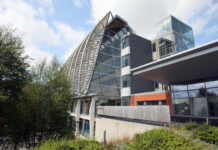

Social entrepreneur and former Secretary General of the Department of Finance John Moran gives his views on the National Development Plan.
DON’T let anyone convince you the National Development Plan (NDP) is a disaster for Limerick. In fact, it has provided the game-changer the city and the region needed.
After years of waiting, the holy grail of a truly sustainable liveable Limerick (indeed mid-west region) is closer to our grasp.
With the promised investment into rail and bus connects, Limerick can steer clear of the horrible spectre of traffic-clogged growth which has bedeviled other regions which have grown quickly.
The credit for this goes to a few key advocates who, with evidence and science, chipped quietly away against all odds and often against more popular or vocal local opinions.
But the match is not won yet. Work still has to be done.
In the ten or so years since returning to Ireland, I have followed Limerick’s development closely and have seen at first-hand two conflicting views about the right path to take.
The National Development Plan (NDP) published this week finally gives a clear direction and, in my opinion, a significant boost to Limerick’s sustainable future and potential.
Firstly, the NDP decisions about new rail investment prove Ireland is really serious about giving us a backbone so that our city can safely double its population.
But, the real game changer for me is how government decided on two key mobility choices for our region.
For decades, our inner city and rural towns have been badly damaged by development which built more and more housing and located jobs at the edge of our city serviced by more and more roads and a bus service unable to cope with the challenges of sprawl.
Increasingly, local advocates argued that within our urban footprint lay underdeveloped sites and derelict buildings with huge potential for exciting new neighbourhoods. They pointed out the untapped advantages of Limerick’s unique (but largely disused) rail network but were often ridiculed as dreamers or told it simply would never happen.
Dublin’s rail projects would soak up all of the available “rail money” we were told and Limerick should just keep to what it knows best – roads.
As traffic increased, most of the Limerick officialdom and elected officials placed their remaining development chips on a square marked ‘Northern Distributor Road’, opening up plans for large scale sprawl to the far west and north east of the city and in to county Clare.
Few of our local TDs, with the notable exception of Brian Leddin, were willing to fight for rail options especially over the locally popular Northern Distributor Road to go all the way to UL.
At odds with the local orthodoxy, national government plans like Project Ireland 2040 called for bigger regional ambition based on compact growth and transport oriented development (which did not mean car transport!).
Strangely, the draft Limerick Shannon Metropolitan Area Transport Strategy (LSMATS) was dominated by road transport principles and car dependency. It met a wave of criticism for overlooking eMobility and rail and not being ambitious enough on active mobility. Then a draft development plan issued which also largely ignored the transformative power of a metropolitan and regional commuter rail network.
Perhaps it had to do with the fact that government policy was not officially there yet.
We ourselves had healthy debates when preparing our key 2019 LiveableLimerick submission to the Southern Regional Assembly, done in collaboration with Limerick Chamber.
At a time when most in Limerick were arguing for more and more roads, we argued the potential of an improved rail network for Limerick and possible rail links to Shannon.
In an important indicator that change was underway, the Southern Regional Assembly Director chose to make reference to our submissions and asked the National Transport Authority (NTA) for clarification on light rail use.
Importantly, the Land Development Agency zeroed in on the untapped potential of Limerick’s rail network as did Jim Meade and his team at Irish Rail.
Regrettably, local Limerick opposition stalled an early 2021 review of the potential for Moyross of a new centrally located station connected to Colbert Quarter and new housing, something promised for several decades.
After the NDP, it is now clearly back to the drawing board for both LSMATS and elements of the development plan and this is to be welcomed.
The full East-West NDR, as we know the project, has not been listed. Instead, the NDP prioritises “the development of a new Limerick commuter rail network including new stations on each of the historical rail lines, the detail of which is to be set out in the Limerick-Shannon Metropolitan Area Transport Strategy.
While some see this as a failure, I believe time will show this to be a key turning point for the better.
Unlike Dublin’s metrolink, rail in Limerick is very feasible (and cheap) to deliver. The state still owns the tracks and land on which to build many of the stations and indeed affordable housing nearby.
Clean battery powered trains could easily make it from Nenagh to Limerick or Limerick to Ennis. Future proofing should now require new housing and jobs be located primarily at future rail hubs throughout our city – in communities like Moyross, Corbally, Parkway, Dooradoyle and Ballysimon.
Colbert Quarter must become the hub around which this all revolves. Instead of focusing on greenfield sites in the west or north accessible only by road, we can develop historic and often neglected communities across our city.
Stations like Ballysimon can become catalysts for rebuilding Galvone and Southill just as Moyross “Village” can be transformed by becoming the first railway stop in Limerick City on the way from Galway or even New York.
Most importantly, a city and region built on a commuter network of rail and bus provides the sustainable solution (key for post COVID recovery) to build up rural towns and villages east, west and south connected directly to the Colbert interchange and the stations in its network by public transport.
If we seize it, our future will be as Ireland’s most affordable, sustainable and liveable region!










